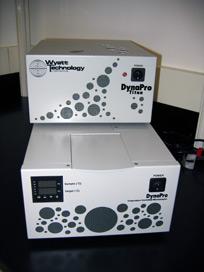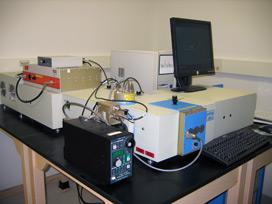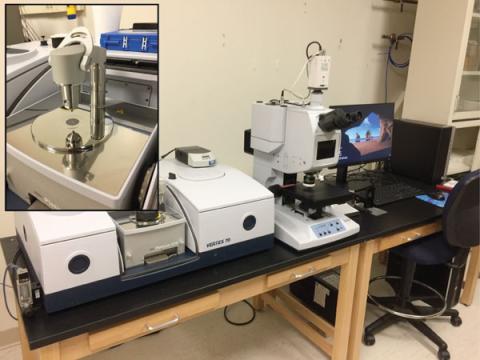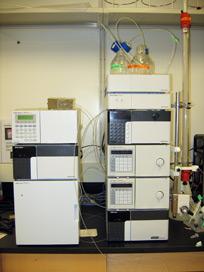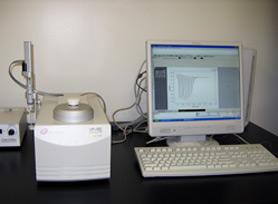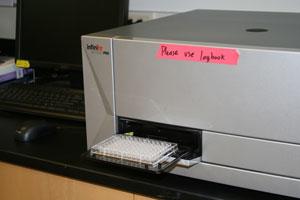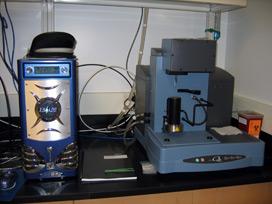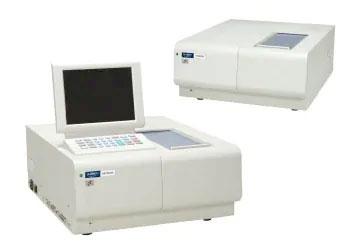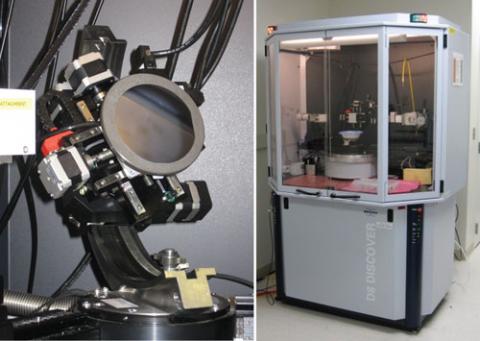The Analytical Biochemistry and Nano-Bio-technology Research Core Facility specializes in measuring physical properties of materials that manifest themselves at the atomic, molecular, and "nano" scales. We routinely work with both biological and materials samples, and the available methodologies include spectroscopy, scattering/diffraction, calorimetry, and chromatography. This core facility has several key pieces of equipment, together with expertise to operate and analyze results, that make the laboratory quite unique. Among these are:
It is used to measure the properties (like mass and shape) of particles (such as proteins) in solution. It can also be used to analyze intramolecular association constants, and as such it is the definitive method for determining the multimeric form of a protein in solution (i.e. whether it is actually a monomer, dimer, etc.). In addition AUC has very high sensitivity, allowing for determination of small amounts of large aggregates in a mostly monomeric solution. This application is particularly important for pharmaceutical companies delivering high concentrated antibodies. AUC provides an accurate way of determining the amount of aggregated material that may pose safety concerns
Small angle x-ray scattering is a technique that makes measurements on the scale 10's to 100's of nanometers, which is a scale of interest for a biological structure and nanotechnology. Our Bruker Nanostar-U SAXS instrument is used in research that includes analysis of proteins in solution, bones, polymers, nanomaterials and macroporous materials. The instrument is equipped with an image plate so that, in addition to the small-angle data, it can also measure wide-angle scattering (simultaneous SAXS-WAXS), which can give information about the sample at the scale of atomic bonds. A laboratory SAXS instrument cannot match the performance at synchrotron source, but it has the advantage that for local users we can provide measurement time frequently and on relatively short notice, which can be a great advantage when SAXS measurements are part a cycle of investigation or development where each step in the process, such as a synthesis, depends on results from a previous step.
The facility has a Bruker D8-Discover XRD. X-ray diffraction provides information about samples at the scale of the atomic bond. It is most applicable to crystalline materials, and is a crucial method for analyzing thin films on wafers, and is thus important for semiconductor research and development. Our instrument is used for a wide range of x-ray diffraction and scattering methods ranging from routine "powder" diffraction measurements to high-resolution and variable temperature measurements.
The infrared region of the spectrum reflects the vibrations of individual chemical bonds. This makes infrared spectroscopy one of the most useful tools available for identifying the chemical nature of materials and analyzing changes at the level of atomic bonds. Our Bruker Vertex 70 Fourier Transform Infrared (FTIR) Spectrometer is equipped to analyze biological and non-biological materials using range of sampling techniques that range from easy and rapid to highly detailed. The spectrometer is coupled with a Bruker Hyperion Infrared Microscope. This instrument can acquire infrared spectra from points in a sample as small as a few microns across. The microscope is very useful for samples such as minerals, glasses, or other macroscopic materials, where different regions of a structure may have different chemical structures.
Providing instrument support for biophysical research is a key focus. The facility is directed by Dr. Joel E. Morgan, an experienced research scientist who trains users to operate the instruments and also supports them in experimental design and data interpretation.
Contact Information:
Joel Morgan, Ph.D.
Analytical Biochemistry Core Director
518-276-4170
morgaj3@rpi.edu
Access to the Analytical Facility and Equipment
Access to all equipment must be approved by the core director. Approved users will have their ID cards activated to access the instrument room.
Training
All users must receive proper training before being permitted access to the equipment. Training is provided by the core director.
Scheduling
Advance reservation using iLab online scheduling calendar (https://rpi.corefacilities.org/account/login)
is required. The billing is based on the length of occupation time, which is calculated based on the equipment computer log records.
Cancellation at least 48 hours prior to the experiment is required. Users failing to do this will be charged (at the hourly rate) for the booked time.
To schedule time in the facility:
- Click on this https://rpi.corefacilities.org/account/login link to open the the iLab website in a new window.
- Click the ‘Login’ button on the site allows you to enter your RCS username and password.
- If you cannot access the instrument calendar you are interested in, please send an email to Marimar Lopez ( lopezm4@rpi.edu) to be assigned the editing capabilities on the calendars you need to access.
Cleaning Up
Users are responsible for keeping the equipment and equipment areas safe and very clean. Failing to maintain this policy will result in loss of use privileges.
Users are encouraged to remove their data from the hard disk of the computer immediately after each session. Long term storage of large quantity of data on the equipment computer is not recommended as the data can be removed from the system without any warning.
Radioactivity
Users are responsible for their compliance with the Radiation and Safety Department at RPI.
Billing
Users will be required to provide billing information prior to requesting instrument time.
Users with multiple billing accounts should specify the account number to be charged upon sign-up. Both internal and external users will be billed on a monthly basis. Providing fraudulent and/or inaccurate billing information may result in the loss of use privileges.
Technology


